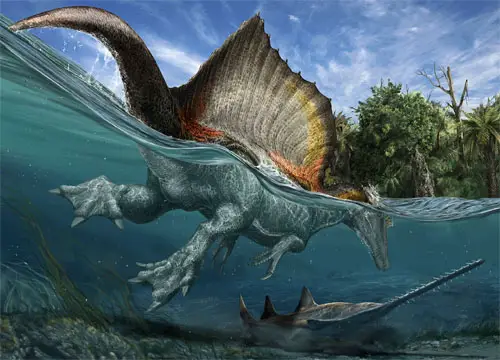Could dinosaurs swim?

As a paleontologist, I often get asked whether dinosaurs could swim. The question is a fascinating one, as it offers insights into the ecological adaptations of these ancient creatures. In this blog post, we will explore the evidence for and against the idea that dinosaurs could swim.
Evidence for Swimming Dinosaurs:
There is some evidence to suggest that certain types of dinosaurs could swim. Fossilized footprints discovered in a quarry in China in 2014 suggest that some dinosaurs, such as the theropod Limusaurus inextricabilis, may have been able to swim. The footprints, which were found in rocks dated to the Late Jurassic period, suggest that the dinosaurs were able to swim across shallow lakes or streams.
Other fossil evidence also suggests that some dinosaurs may have been adapted to an aquatic lifestyle. For example, the Spinosaurus, a theropod dinosaur that lived during the Late Cretaceous period, had a long, crocodile-like snout and powerful hind legs that suggest it may have been adapted to swimming and hunting in water.
Evidence Against Swimming Dinosaurs:
However, other fossil evidence suggests that most dinosaurs were not well-suited to swimming. For example, many types of dinosaurs had heavy, bulky bodies that would have made swimming difficult. Additionally, most dinosaur fossils have been found on land, suggesting that these creatures spent most of their time on dry ground.
Moreover, while some dinosaur species may have had features that could be interpreted as adaptations for swimming, such as webbed feet or long snouts, it is difficult to determine whether these features were actually used for swimming or had other purposes. For example, the long snout of Spinosaurus may have been used for catching fish while standing in shallow water rather than for swimming.
Conclusion:
In conclusion, while there is some evidence to suggest that certain types of dinosaurs may have been able to swim, the reality is that most dinosaurs were not well-suited to an aquatic lifestyle. Fossil evidence is limited and difficult to interpret, and it is challenging to determine whether features that might be interpreted as adaptations for swimming were actually used for that purpose. Nonetheless, ongoing exploration and study of fossil evidence continues to provide new insights into the behavior and adaptations of these fascinating creatures.
